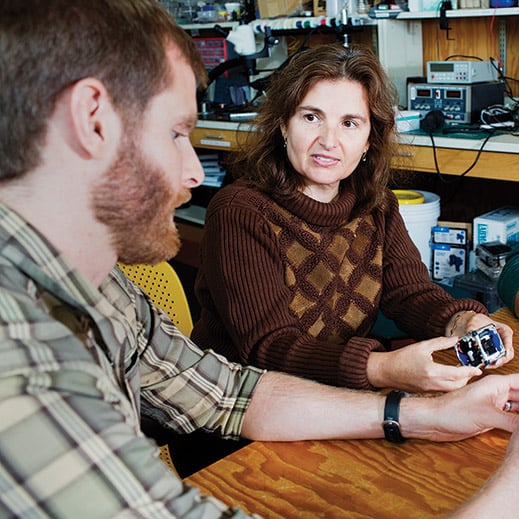In 2011, when an MIT senior named John Romanishin proposed a new design for modular robots to his robotics professor, Daniela Rus, she said, “That can’t be done.”

Two years later, Rus showed a colleague at Cornell University a video of prototype robots based on Romanishin’s design. “That can’t be done,” he said.
In November, Romanishin—now a research scientist in MIT’s Computer Science and Artificial Intelligence Laboratory (CSAIL)—established once and for all that it could be done, when he, Rus, and postdoc Kyle Gilpin presented their robots at the IEEE/RSJ International Conference on Intelligent Robots and Systems.
Known as M-Blocks, the robots are cubes with no external moving parts. Nonetheless, they’re able to climb over and around one another, roll across the ground, and even leap through the air.
Inside each M-Block is a flywheel that can reach speeds of 20,000 revolutions per minute; when the flywheel is braked, it imparts its angular momentum to the cube.
Simple self-assembling robots that can directly slide or pivot about each other are “one of these things that the [modular-robotics] community has been trying to do for a long time,” says Rus, a professor of electrical engineering and computer science and director of CSAIL. “We just needed a creative insight and somebody who was passionate enough to keep coming at it—despite being discouraged.”
On each edge of a cube are two cylindrical magnets, mounted like rolling pins. When two cubes approach each other, the magnets rotate so that north poles align with south and vice versa. So any face of any cube can attach to any face of any other.
The cubes’ edges are also beveled, so when two cubes are face to face, there’s a slight gap between their magnets. When one cube begins to flip on top of another, the bevels, and thus the magnets, touch. The connection between the cubes becomes stronger, anchoring the pivot.
As with any modular-robot system, the hope is that the modules can be miniaturized. But the researchers believe that a more refined version of their system could prove useful even at something like its current scale, temporarily repairing bridges or buildings during emergencies, raising and reconfiguring scaffolding for building projects, or swarming into environments hostile or inaccessible to humans to diagnose problems and reorganize themselves into solutions.
Keep Reading
Most Popular
Large language models can do jaw-dropping things. But nobody knows exactly why.
And that's a problem. Figuring it out is one of the biggest scientific puzzles of our time and a crucial step towards controlling more powerful future models.
The problem with plug-in hybrids? Their drivers.
Plug-in hybrids are often sold as a transition to EVs, but new data from Europe shows we’re still underestimating the emissions they produce.
Google DeepMind’s new generative model makes Super Mario–like games from scratch
Genie learns how to control games by watching hours and hours of video. It could help train next-gen robots too.
How scientists traced a mysterious covid case back to six toilets
When wastewater surveillance turns into a hunt for a single infected individual, the ethics get tricky.
Stay connected
Get the latest updates from
MIT Technology Review
Discover special offers, top stories, upcoming events, and more.